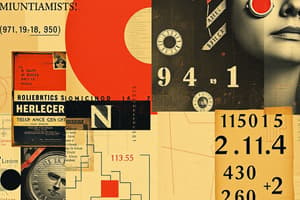Podcast
Questions and Answers
What is the primary purpose of rounding numbers?
What is the primary purpose of rounding numbers?
The primary purpose of rounding numbers is to approximate a number to a specified degree of accuracy.
When rounding the number 4.67 to the nearest whole number, what result do you obtain?
When rounding the number 4.67 to the nearest whole number, what result do you obtain?
You obtain 5 after rounding up.
Explain the rule for rounding to the nearest tenth using the number 2.34.
Explain the rule for rounding to the nearest tenth using the number 2.34.
2.34 rounds down to 2.3 because the digit in the hundredths place is less than 5.
If you round the number 5.555 to two decimal places, what is the result?
If you round the number 5.555 to two decimal places, what is the result?
What should you do when the digit you are rounding is part of a series of consecutive 9s?
What should you do when the digit you are rounding is part of a series of consecutive 9s?
In significant figures, how does rounding affect the results of calculations?
In significant figures, how does rounding affect the results of calculations?
How does the context of a problem influence the rounding precision needed?
How does the context of a problem influence the rounding precision needed?
What rounding result do you get for the number 3.299 when rounding to the nearest tenth?
What rounding result do you get for the number 3.299 when rounding to the nearest tenth?
Flashcards
Rounding
Rounding
Approximating a number to a specific degree of accuracy.
Rounding rules
Rounding rules
Specific guidelines for approximating numbers based on the digit following the place value.
Rounding up
Rounding up
Increasing the digit in the designated place value by 1 when the next digit is 5 or more.
Rounding down
Rounding down
Signup and view all the flashcards
Significant figures
Significant figures
Signup and view all the flashcards
Rounding to nearest whole number
Rounding to nearest whole number
Signup and view all the flashcards
Rounding to specific place value
Rounding to specific place value
Signup and view all the flashcards
Rounding with zeros
Rounding with zeros
Signup and view all the flashcards
Study Notes
Rounding Rules Overview
- Rounding is a process of approximating a number to a specified degree of accuracy.
- It's a crucial technique in mathematics, science, and everyday life.
- Rules vary depending on the digit to which the number needs to be rounded.
Rounding to a Specific Place Value
- Identify the place value to which you want to round.
- Look at the digit immediately to the right of the designated place value.
- If the digit is 5 or greater, round up the digit in the designated place value.
- If the digit is less than 5, round down (keep the digit in the designated place value unchanged).
Example Cases
- Rounding to the nearest whole number:
- 3.2 rounds down to 3.
- 3.8 rounds up to 4.
- Rounding to the nearest tenth:
- 3.24 rounds down to 3.2
- 3.26 rounds up to 3.3
- Rounding to the nearest hundredth:
- 3.245 rounds up to 3.25
- 3.244 rounds down to 3.24
Special Cases: Rounding to Zero Decimals (Nearest Whole Number)
- Look at the digit in the tenths place.
- If it's 5 or greater, round the ones digit up.
- If it's less than 5, round the ones digit down.
Rounding with Zeros
- When rounding, sometimes you add zeros to maintain the place value.
- Example: Rounding 3.299 to the nearest tenth gives 3.3.
- Example: Rounding 20.3456 to the nearest whole number gives 20.
Significant Figures and Rounding
- Significant figures are the digits in a number that carry meaning contributing to its measurement resolution.
- Rounding is used when reporting a calculation using significant figures.
- The result is rounded to the least number of significant figures in the original inputs.
Important Considerations
-
Rounding can impact calculations and results. Understanding the rules is critical for accuracy.
- When dealing with consecutive digits that are all 9s, adding one to the highest place will cause a ripple effect.
-
The context of the problem dictates the appropriate level of rounding precision.
- Consider the context of the problem (engineering, science, etc.).
- It is critical to maintain consistent rounding to ensure reliability and repeatability.
Studying That Suits You
Use AI to generate personalized quizzes and flashcards to suit your learning preferences.




